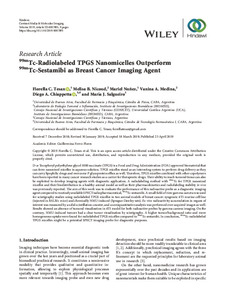Por favor, use este identificador para citar o enlazar este ítem:
https://repositorio.uca.edu.ar/handle/123456789/8698| Título: | 99mTc-radiolabeled TPGS nanomicelles outperform 99mTc-sestamibi as breast cancer imaging agent | Autor: | Tesan, Fiorella C. Nicoud, Melisa Beatriz Núñez, Mariel Medina, Vanina Araceli Chiappetta, Diego A. Salgueiro, María J. |
Palabras clave: | MEDICINA; CANCER; ONCOLOGIA; DIAGNOSTICO POR IMAGEN; BIOMATERIALES | Fecha de publicación: | 2019 | Editorial: | The Wiley Hindawi Partnership | Cita: | Tesan F.C., et al. 99mTc-radiolabeled TPGS nanomicelles outperform 99mTc-sestamibi as breast cancer imaging agent [en línea]. Contrast Media & Molecular Imaging, 2019. doi: 10.1155/2019/4087895. Disponible en: https://repositorio.uca.edu.ar/handle/123456789/8698 | Resumen: | Abstract: D- α-Tocopheryl polyethylene glycol 1000 succinate (TPGS) is a Food and Drug Administration (FDA) approved biomaterial that can form nanosized micelles in aqueous solution. TPGS micelles stand as an interesting system to perform drug delivery as they can carry lipophilic drugs and overcome P glycoprotein efflux as well. Berefore, TPGS micelles combined with other copolymers have been reported in many cancer research studies as a carrier for therapeutic drugs. Their ability to reach tumoral tissue can also be exploited to develop imaging agents with diagnostic application. A radiolabeling method with 99mTc for TPGS nanosized micelles and their biodistribution in a healthy animal model as well as their pharmacokinetics and radiolabeling stability in vivo was previously reported. The aim of this work was to evaluate the performance of this radioactive probe as a diagnostic imaging agent compared to routinely available SPECTradiopharmaceutical, 99mTc-sestamibi. A small field of view gamma camera was used for scintigraphy studies using radiolabeled TPGS micelles in two animal models of breast cancer: syngeneic 4T1 murine cell line (injected in BALB/c mice) and chemically NMU-induced (Sprague-Dawley rats). Ex vivo radioactivity accumulation in organs of interest was measured by a solid scintillation counter, and a semiquantitative analysis was performed over acquired images as well. Results showed an absence of tumoral visualization in 4T1 model for both radioactive probes by gamma camera imaging. On the contrary, NMU-induced tumors had a clear tumor visualization by scintigraphy. A higher tumor/background ratio and more homogeneous uptake were found for radiolabeled TPGS micelles compared to 99mTc-sestamibi. In conclusion, 99mTc-radiolabeled TPGS micelles might be a potential SPECT imaging probe for diagnostic purposes. | URI: | https://repositorio.uca.edu.ar/handle/123456789/8698 | ISSN: | 1555-4317 (en línea) 1555-4309 (impreso) |
Disciplina: | MEDICINA | DOI: | 10.1155/2019/4087895 | Derechos: | Acceso abierto | Fuente: | Contrast Media & Molecular Imaging Vol. 2019 |
| Aparece en las colecciones: | Artículos |
Ficheros en este ítem:
| Fichero | Descripción | Tamaño | Formato | |
|---|---|---|---|---|
| 99mtc-radiolabeled-tpgs-nanomicelles.pdf | 2,63 MB | Adobe PDF |  Visualizar/Abrir |
Visualizaciones de página(s)
330
comprobado en 05-ene-2026
Descarga(s)
210
comprobado en 05-ene-2026
Google ScholarTM
Ver en Google Scholar
Altmetric
Altmetric
Este ítem está sujeto a una Licencia Creative Commons

